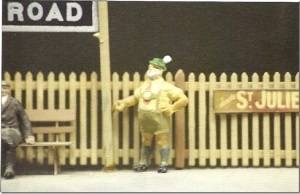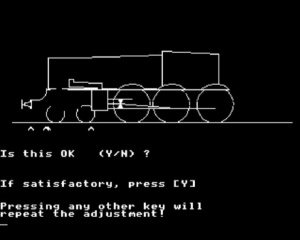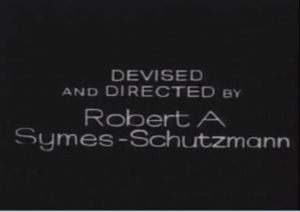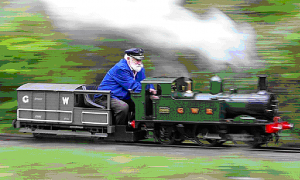Alec Bray
Many of us have worked with Bob Symes – or Bob Symes-Schutzmann as he was known for most of his BBC years. He worked with Raymond Baxter on “Tomorrow’s World” (query as producer and presenter?) and on some other programmes, including railway programmes.
Unfortunately, Bob died, aged 90, on 15th January 2015. His full moniker was Robert Alexander Baron Schutzmann von Schutzmansdorff although for many of his later years he was known simply as Bob Symes. It is not mentioned in his Wikipedia entry, but his was the voice of the Madder Valley Railway at Pendon Museum – or rather, again to give it its full title, Pendon Museum of Miniature Landscape and Modelling – at Long Wittenham, near Abingdon (Oxon).
The principal scene at Pendon attempts to capture the landscape (and railways) in the Vale of the White Horse as it was during the mid 1930s – a scene almost obliterated now- chalk roads have gone, outside privvies have gone, hand workers in the fields have gone … and if anyone is in the Didcot area on a weekend afternoon, it’s an interesting place to visit. And you can also visit Wittenham Clumps.
Anyway, Bob Symes was a great supporter of Pendon, and he has been captured in miniature at Pen Tor Road Station (on a Dartmoor scene) in his lederhosen as shewn in the picture below.
(Click on the picture below to see larger version:
use your Browser’s BACK button to return to this page)
A couple of points – the model is less than 20 mm high (it is to 4mm to the foot scale (Hornby railways to the uninitiated)) so the picture is larger than life! and it is “shewn” because this is Great Western Railway territory!
I personally never worked with Bob Symes, but I did meet him in the early 1980s at a model engineering exhibition in Reading. He was there with a live steam Gauge 1 GWR King class locomotive – absolutely beautiful – but what was more exciting was that he also had a Gauge 1 model of a Brush class 47 Diesel-Electric – which was almost exactly that! A model aero engine drove a generator, which in turn was connected up to the bogie mounted traction motors. A marvellous piece of engineering – and quite fearsome when it started up.
I was “exhibiting” at the same exhibition with a BBC Micro (and TV set) and was demonstrating a program which let people “design” Great Western Locomotives – here’s the idea:
(Click on the picture below to see larger version:
use your Browser’s BACK button to return to this page)
(and it took up ALL the memory …)
Bob came rushing up with a friend of his – and a big book – and said that he wanted to draw one of the locos from this book. He asked me to put in all the data that the program required as he quoted dimensions from the book. When we had finished, he turned to his friend and said – “There, told you so. This loco was designed using Great Western design principles!” Amazing, since the loco in question was French ….
The loco drawing program was originally written to show boys at the school where I was teaching a very (very) simple approach to Computer Aided Design, and how arrays could be used to store data. The program was eventually commercially published for sale to educational establishments.
To complete the tale, I rewrote the GWR Locomotive Sketchpad for Windows and UNIX PCs starting in year 2000 and it is now available through the Great Western Society at Didcot.
(Click on the picture below to see larger version:
use your Browser’s BACK button to return to this page)
Bernie Newnham
I was at Pendon the other week (April 2015) with an OO gauge enthusiast friend. A fascinating place – and on the various screens a video was running. I recognised the voice-over but couldn’t put a name to it. Then it came to me – it was Robert Alexander Baron Schutzmann von Schutzmansdorff .
Albert Barber
Interesting how names trigger memories of people you met years ago.
When I started at the BBC I was a film assistant in the Steinbeck room in the East Tower at Television Centre. Bob worked then for “Tomorrow’s World” and brought films in to view. I remember that he had the idea to patent an invention of his: The no smell toilet. it may well have been on Tomorrow’s World. There was an extra vent near to where the water entered the bowl and a fan to extract the smell. He seemed to me to be a bit like James Roberson Justice and one of the first of the many characters that existed at the BBC when I joined in the late 1960s. There were many characters who made for the rich diversity of programmes when I joined who nowadays would not be employed at the BBC. Programmes were the richer for them and I would say Bob was one of them. I always felt pleased to have met him and like many characters made a genuine contribution to the BBC and programme making. To name a few I consider Peter Wiltshire, a cameraman and “Playschool” director, one of these people. Peter was quite eccentric in the best possible way and when stuck on an edit he inserted a shot of the toy Humpty between shots which jolted us out of our seats. On recovering we said how could he do such a dreadful edit. He replied something like "…The children won’t mind and anyway Humpty was enjoying it…". He had exactly the right attitude to the programme and more importantly the audience.
Roger Bunce
I vaguely remember a BBC programme, possibly a series, following the gradual construction of a 00 gauge model railway station. I think it was intended to be a replica of Horstead Keynes on the Bluebell Line. Bob Symes was the presenter, and the model makers were familiar faces from the BBC Special Effects dept. (Jack Kine, Matt Irvine, possibly.) I remember being disappointed by the way it was shot. These were the days before mini-cams that could get down to 00 gauge ground level.
Pat Heigham
Bob Symes lived not far from me at East Horsley, I used to walk my friends’ dogs and peer over his garden fence at his outdoor railway layout.
Long Wittenham rings a bell – late 1950s, I canoe’d down the Thames with a school friend, staying in Youth Hostels en route. One was Long Wittenham, and approaching the house, there was a note on the front door instructing entry via the back door. Once inside, it became apparent why the front door was inaccessible – there was a smoke stack from a steam loco as a huge door stop! And a signal post in the garden.
After supper, we were invited to view the model railway layout built by the warden, a beautiful and highly detailed section of part of the route over Dartmoor. The carriages were lit, and had miniature reproductions of the posters of the time. The little houses (I think a separate model, were thatched with human hair!)
Could this be the present museum?
(ed: YES!)
Bill Jenkin
Wynford Vaughan Thomas on the closing of the Mumbles Railway.
"… This film was a joint operation by the Model Railway Society and the Film Society BBC Club…"
and it was devised and directed by Bob Symes Shutzman:
(Click on the picture below to see larger version:
use your Browser’s BACK button to return to this page)
(Click on the picture below to see larger version:
use your Browser’s BACK button to return to this page)








